Instructor’s Manual:
Exercise Solutions
for
Artificial Intelligence
A Modern Approach
Second Edition
Stuart J. Russell and Peter Norvig
Upper Saddle River, New Jersey 07458
�
Library of Congress Cataloging-in-Publication Data
Russell, Stuart J. (Stuart Jonathan)
Instructor’s solution manual for artificial intelligence : a modern approach
(second edition) / Stuart Russell, Peter Norvig.
Includes bibliographical references and index.
I. Norvig, Peter. II. Title.
1. Artificial intelligence
Vice President and Editorial Director, ECS: Marcia J. Horton
Publisher: Alan R. Apt
Associate Editor: Toni Dianne Holm
Editorial Assistant: Patrick Lindner
Vice President and Director of Production and Manufacturing, ESM: David W. Riccardi
Executive Managing Editor: Vince O’Brien
Managing Editor: Camille Trentacoste
Production Editor: Mary Massey
Manufacturing Manager: Trudy Pisciotti
Manufacturing Buyer: Lisa McDowell
Marketing Manager: Pamela Shaffer
2003 Pearson Education, Inc.
c�
Pearson Prentice Hall
Pearson Education, Inc.
Upper Saddle River, NJ 07458
All rights reserved. No part of this manual may be reproduced in any form or by any means, without
permission in writing from the publisher.
Pearson Prentice Hall R�
is a trademark of Pearson Education, Inc.
Printed in the United States of America
10 9
8 7
6 5
4 3
2 1
ISBN: 0-13-090376-0
Pearson Education Ltd., London
Pearson Education Australia Pty. Ltd., Sydney
Pearson Education Singapore, Pte. Ltd.
Pearson Education North Asia Ltd., Hong Kong
Pearson Education Canada, Inc., Toronto
Pearson Educaci´on de Mexico, S.A. de C.V.
Pearson Education—Japan, Tokyo
Pearson Education Malaysia, Pte. Ltd.
Pearson Education, Inc., Upper Saddle River, New Jersey
�
Preface
This Instructor’s Solution Manual provides solutions (or at least solution sketches) for
almost all of the 400 exercises in Artificial Intelligence: A Modern Approach (Second Edi-
tion). We only give actual code for a few of the programming exercises; writing a lot of code
would not be that helpful, if only because we don’t know what language you prefer.
In many cases, we give ideas for discussion and follow-up questions, and we try to
explain why we designed each exercise.
There is more supplementary material that we want to offer to the instructor, but we
have decided to do it through the medium of the World Wide Web rather than through a CD
or printed Instructor’s Manual. The idea is that this solution manual contains the material that
must be kept secret from students, but the Web site contains material that can be updated and
added to in a more timely fashion. The address for the web site is:
http://aima.cs.berkeley.edu
and the address for the online Instructor’s Guide is:
http://aima.cs.berkeley.edu/instructors.html
There you will find:
Instructions on how to join the aima-instructors discussion list. We strongly recom-
mend that you join so that you can receive updates, corrections, notification of new
versions of this Solutions Manual, additional exercises and exam questions, etc., in a
timely manner.
� Source code for programs from the text. We offer code in Lisp, Python, and Java, and
point to code developed by others in C++ and Prolog.
� Programming resources and supplemental texts.
� Figures from the text; for overhead transparencies.
� Terminology from the index of the book.
� Other courses using the book that have home pages on the Web. You can see example
syllabi and assignments here. Please do not put solution sets for AIMA exercises on
public web pages!
� AI Education information on teaching introductory AI courses.
� Other sites on the Web with information on AI. Organized by chapter in the book; check
this for supplemental material.
We welcome suggestions for new exercises, new environments and agents, etc. The
book belongs to you, the instructor, as much as us. We hope that you enjoy teaching from it,
that these supplemental materials help, and that you will share your supplements and experi-
ences with other instructors.
iii
�
�
�
Solutions for Chapter 1
Introduction
1.1
a. Dictionary definitions of intelligence talk about “the capacity to acquire and apply
knowledge” or “the faculty of thought and reason” or “the ability to comprehend and
profit from experience.” These are all reasonable answers, but if we want something
quantifiable we would use something like “the ability to apply knowledge in order to
perform better in an environment.”
b. We define artificial intelligence as the study and construction of agent programs that
perform well in a given environment, for a given agent architecture.
c. We define an agent as an entity that takes action in response to percepts from an envi-
ronment.
1.2 See the solution for exercise 26.1 for some discussion of potential objections.
The probability of fooling an interrogator depends on just how unskilled the interroga-
tor is. One entrant in the 2002 Loebner prize competition (which is not quite a real Turing
Test) did fool one judge, although if you look at the transcript, it is hard to imagine what
that judge was thinking. There certainly have been examples of a chatbot or other online
agent fooling humans. For example, see See Lenny Foner’s account of the Julia chatbot
at foner.www.media.mit.edu/people/foner/Julia/. We’d say the chance today is something
like 10%, with the variation depending more on the skill of the interrogator rather than the
program. In 50 years, we expect that the entertainment industry (movies, video games, com-
mercials) will have made sufficient investments in artificial actors to create very credible
impersonators.
1.3 The 2002 Loebner prize (www.loebner.net) went to Kevin Copple’s program ELLA. It
consists of a prioritized set of pattern/action rules: if it sees a text string matching a certain
pattern, it outputs the corresponding response, which may include pieces of the current or
past input. It also has a large database of text and has the Wordnet online dictionary. It is
therefore using rather rudimentary tools, and is not advancing the theory of AI. It is provid-
ing evidence on the number and type of rules that are sufficient for producing one type of
conversation.
1.4 No. It means that AI systems should avoid trying to solve intractable problems. Usually,
this means they can only approximate optimal behavior. Notice that humans don’t solve NP-
complete problems either. Sometimes they are good at solving specific instances with a lot of
1
�
2
Chapter 1.
Introduction
structure, perhaps with the aid of background knowledge. AI systems should attempt to do
the same.
1.5 No. IQ test scores correlate well with certain other measures, such as success in college,
but only if they’re measuring fairly normal humans. The IQ test doesn’t measure everything.
A program that is specialized only for IQ tests (and specialized further only for the analogy
part) would very likely perform poorly on other measures of intelligence. See The Mismea-
sure of Man by Stephen Jay Gould, Norton, 1981 or Multiple intelligences: the theory in
practice by Howard Gardner, Basic Books, 1993 for more on IQ tests, what they measure,
and what other aspects there are to “intelligence.”
1.6
Just as you are unaware of all the steps that go into making your heart beat, you are
also unaware of most of what happens in your thoughts. You do have a conscious awareness
of some of your thought processes, but the majority remains opaque to your consciousness.
The field of psychoanalysis is based on the idea that one needs trained professional help to
analyze one’s own thoughts.
1.7
a. (ping-pong) A reasonable level of proficiency was achieved by Andersson’s robot (An-
dersson, 1988).
b. (driving in Cairo) No. Although there has been a lot of progress in automated driving,
all such systems currently rely on certain relatively constant clues: that the road has
shoulders and a center line, that the car ahead will travel a predictable course, that cars
will keep to their side of the road, and so on. To our knowledge, none are able to avoid
obstacles or other cars or to change lanes as appropriate; their skills are mostly confined
to staying in one lane at constant speed. Driving in downtown Cairo is too unpredictable
for any of these to work.
c. (shopping at the market) No. No robot can currently put together the tasks of moving in
a crowded environment, using vision to identify a wide variety of objects, and grasping
the objects (including squishable vegetables) without damaging them. The component
pieces are nearly able to handle the individual tasks, but it would take a major integra-
tion effort to put it all together.
d. (shopping on the web) Yes. Software robots are capable of handling such tasks, par-
ticularly if the design of the web grocery shopping site does not change radically over
time.
e. (bridge) Yes. Programs such as GIB now play at a solid level.
f. (theorem proving) Yes. For example, the proof of Robbins algebra described on page
309.
g. (funny story) No. While some computer-generated prose and poetry is hysterically
funny, this is invariably unintentional, except in the case of programs that echo back
prose that they have memorized.
h. (legal advice) Yes, in some cases. AI has a long history of research into applications
of automated legal reasoning. Two outstanding examples are the Prolog-based expert
�
3
systems used in the UK to guide members of the public in dealing with the intricacies of
the social security and nationality laws. The social security system is said to have saved
the UK government approximately $150 million in its first year of operation. However,
extension into more complex areas such as contract law awaits a satisfactory encoding
of the vast web of common-sense knowledge pertaining to commercial transactions and
agreement and business practices.
i. (translation) Yes. In a limited way, this is already being done. See Kay, Gawron and
Norvig (1994) and Wahlster (2000) for an overview of the field of speech translation,
and some limitations on the current state of the art.
j. (surgery) Yes. Robots are increasingly being used for surgery, although always under
the command of a doctor.
1.8 Certainly perception and motor skills are important, and it is a good thing that the fields
of vision and robotics exist (whether or not you want to consider them part of “core” AI).
But given a percept, an agent still has the task of “deciding” (either by deliberation or by
reaction) which action to take. This is just as true in the real world as in artificial micro-
worlds such as chess-playing. So computing the appropriate action will remain a crucial part
of AI, regardless of the perceptual and motor system to which the agent program is “attached.”
On the other hand, it is true that a concentration on micro-worlds has led AI away from the
really interesting environments (see page 46).
1.9 Evolution tends to perpetuate organisms (and combinations and mutations of organ-
isms) that are succesful enough to reproduce. That is, evolution favors organisms that can
optimize their performance measure to at least survive to the age of sexual maturity, and then
be able to win a mate. Rationality just means optimizing performance measure, so this is in
line with evolution.
1.10 Yes, they are rational, because slower, deliberative actions would tend to result in
more damage to the hand. If “intelligent” means “applying knowledge” or “using thought
and reasoning” then it does not require intelligence to make a reflex action.
1.11 This depends on your definition of “intelligent” and “tell.” In one sense computers only
do what the programmers command them to do, but in another sense what the programmers
consciously tells the computer to do often has very little to do with what the computer actually
does. Anyone who has written a program with an ornery bug knows this, as does anyone
who has written a successful machine learning program. So in one sense Samuel “told” the
computer “learn to play checkers better than I do, and then play that way,” but in another
sense he told the computer “follow this learning algorithm” and it learned to play. So we’re
left in the situation where you may or may not consider learning to play checkers to be s sign
of intelligence (or you may think that learning to play in the right way requires intelligence,
but not in this way), and you may think the intelligence resides in the programmer or in the
computer.
1.12 The point of this exercise is to notice the parallel with the previous one. Whatever you
decided about whether computers could be intelligent in 1.9, you are committed to making the
�
4
Chapter 1.
Introduction
same conclusion about animals (including humans), unless your reasons for deciding whether
something is intelligent take into account the mechanism (programming via genes versus
programming via a human programmer). Note that Searle makes this appeal to mechanism
in his Chinese Room argument (see Chapter 26).
1.13 Again, the choice you make in 1.11 drives your answer to this question.
�
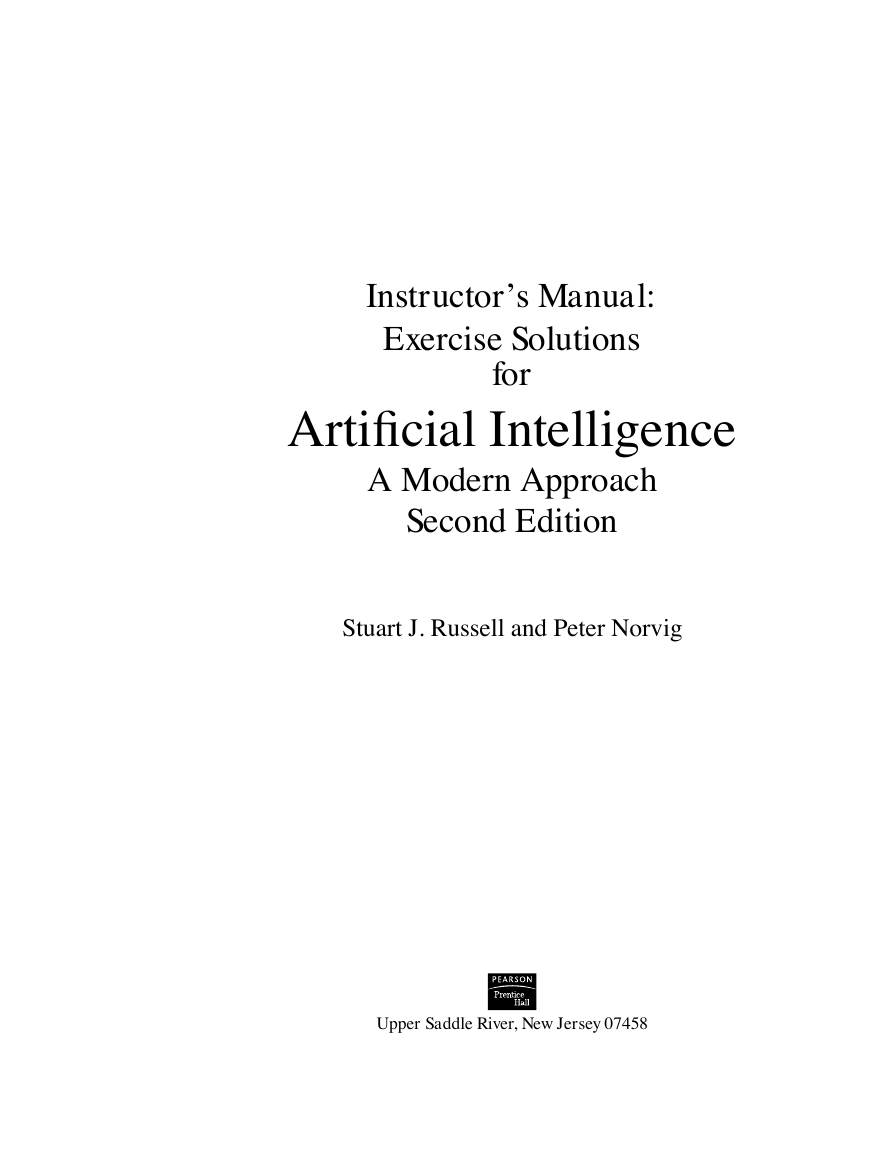
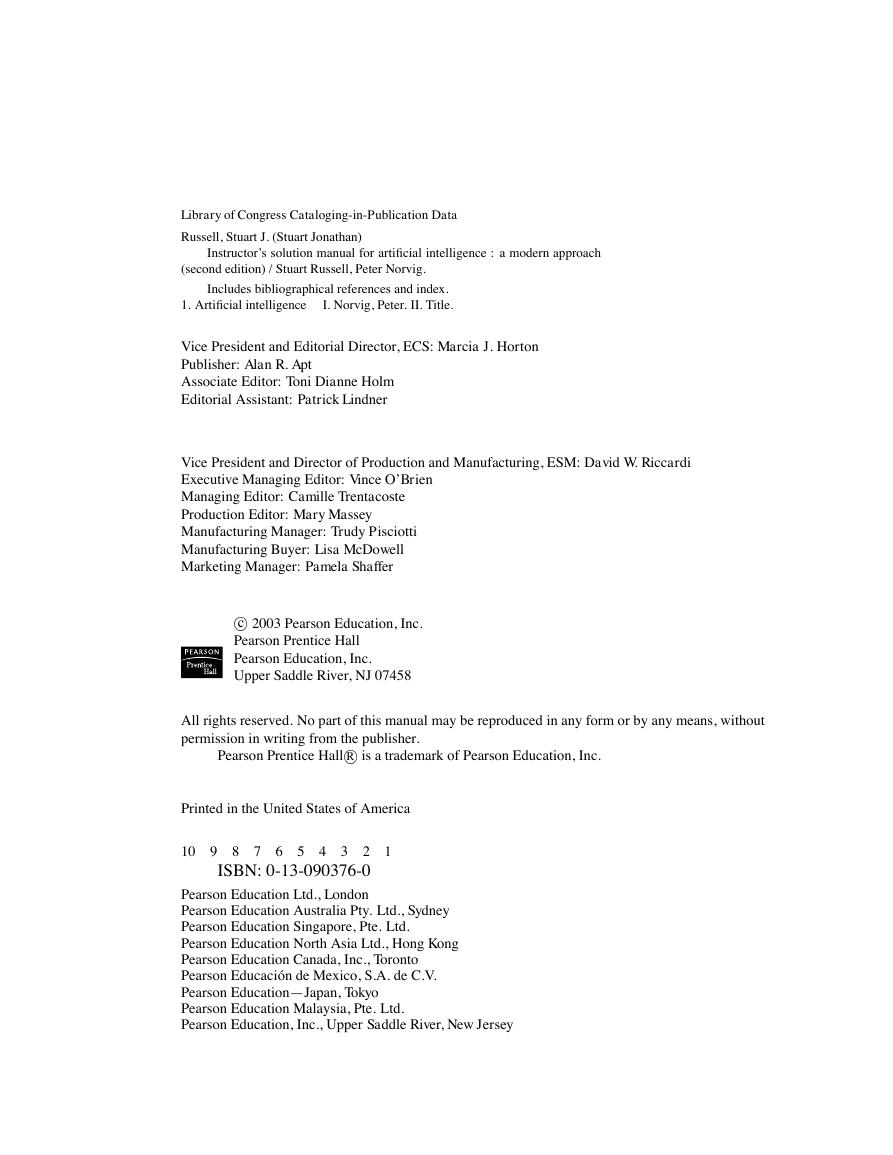
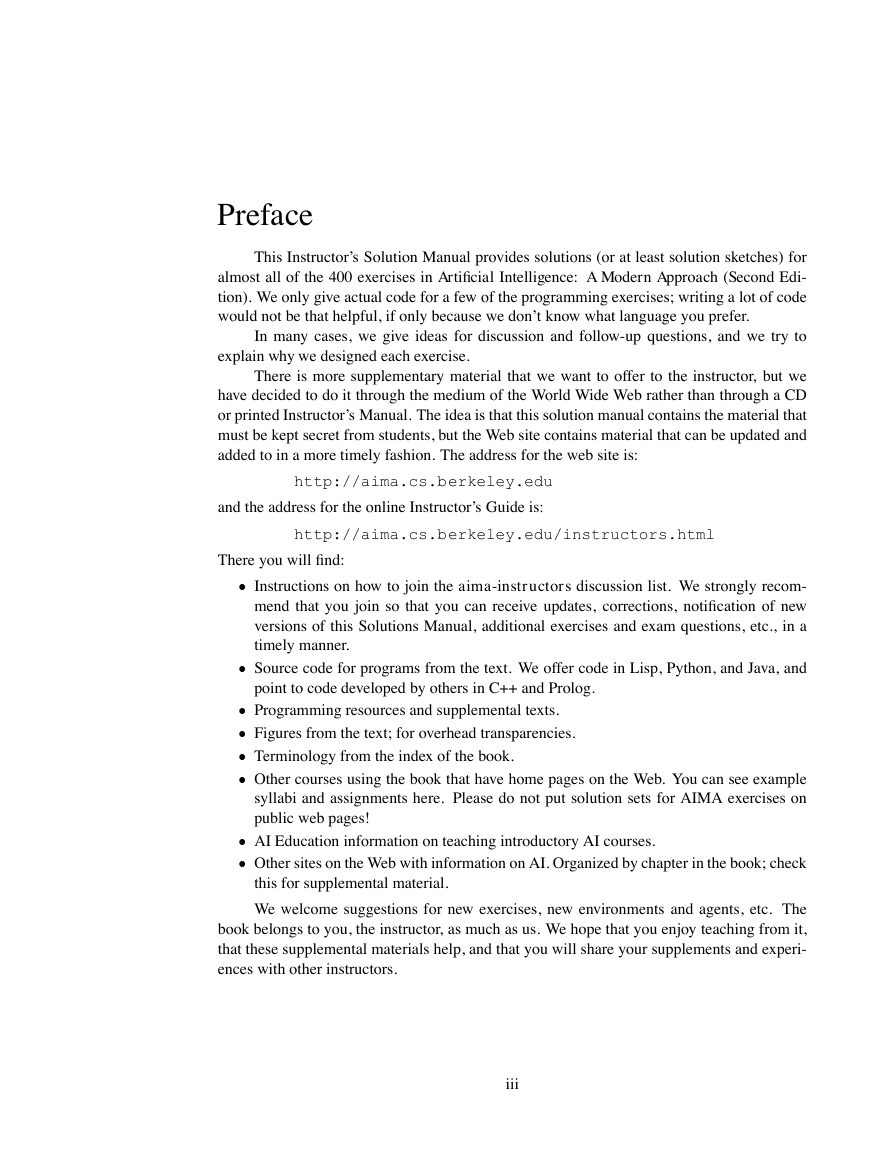

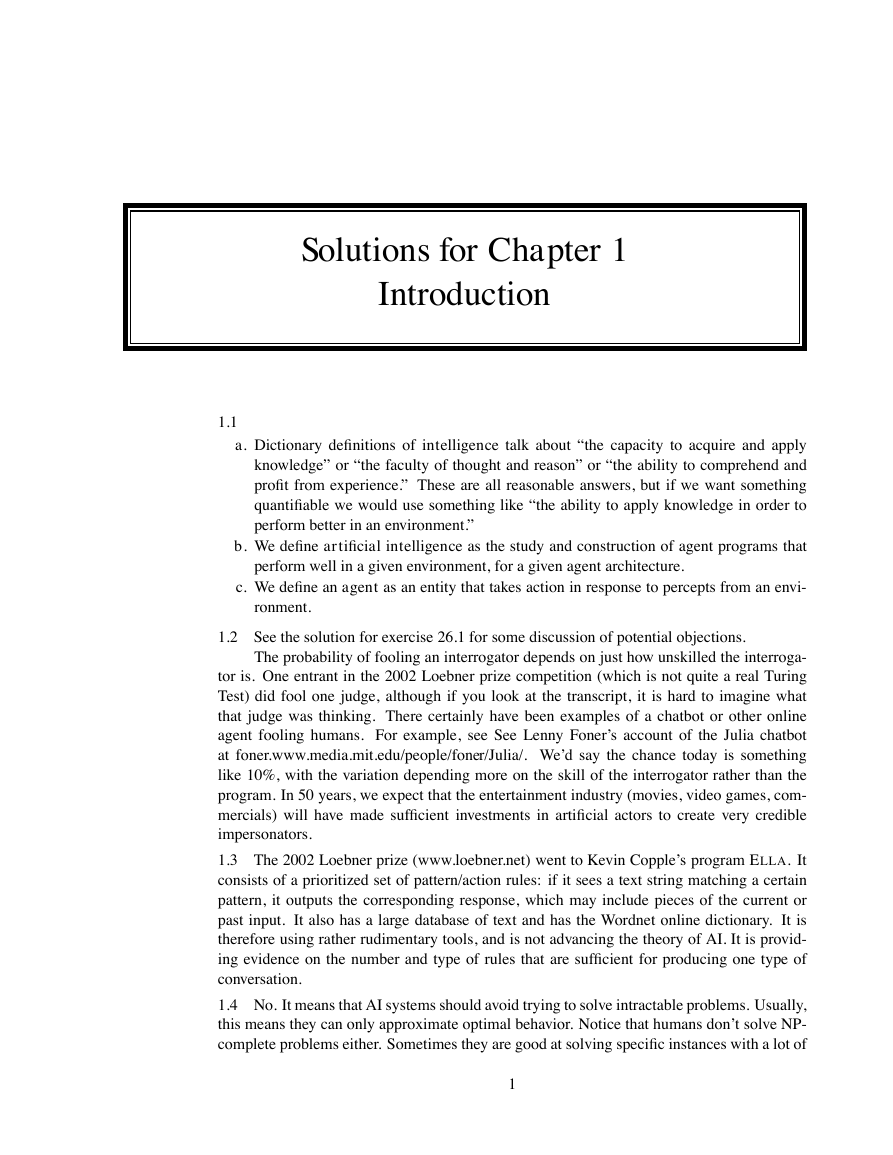
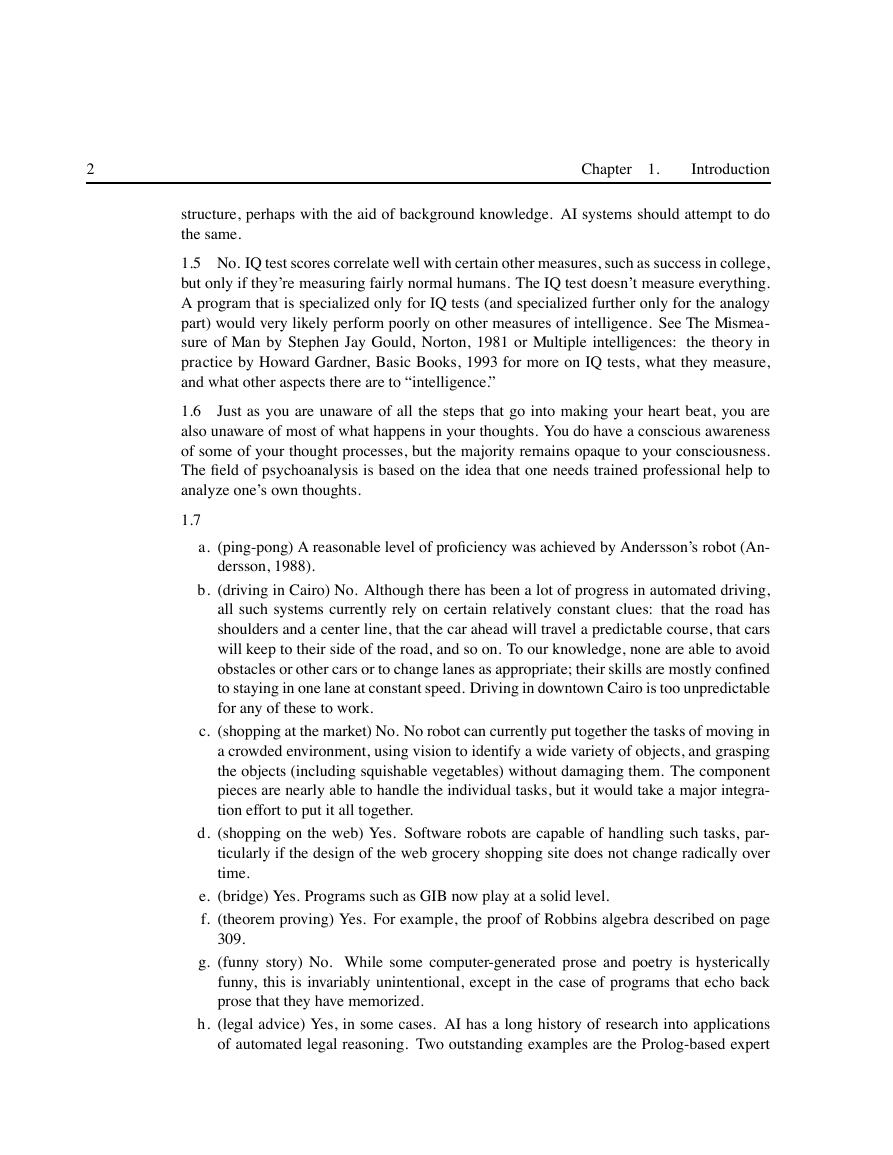
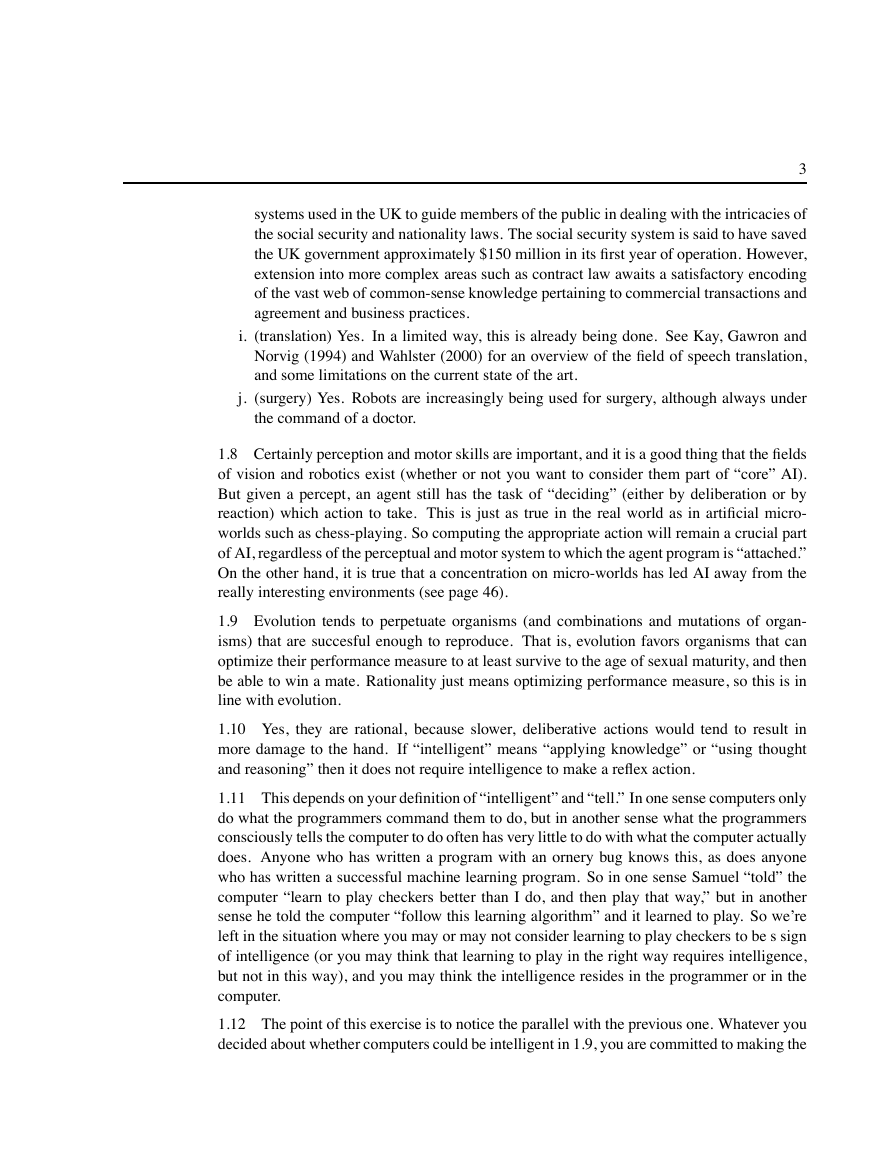









 2023年江西萍乡中考道德与法治真题及答案.doc
2023年江西萍乡中考道德与法治真题及答案.doc 2012年重庆南川中考生物真题及答案.doc
2012年重庆南川中考生物真题及答案.doc 2013年江西师范大学地理学综合及文艺理论基础考研真题.doc
2013年江西师范大学地理学综合及文艺理论基础考研真题.doc 2020年四川甘孜小升初语文真题及答案I卷.doc
2020年四川甘孜小升初语文真题及答案I卷.doc 2020年注册岩土工程师专业基础考试真题及答案.doc
2020年注册岩土工程师专业基础考试真题及答案.doc 2023-2024学年福建省厦门市九年级上学期数学月考试题及答案.doc
2023-2024学年福建省厦门市九年级上学期数学月考试题及答案.doc 2021-2022学年辽宁省沈阳市大东区九年级上学期语文期末试题及答案.doc
2021-2022学年辽宁省沈阳市大东区九年级上学期语文期末试题及答案.doc 2022-2023学年北京东城区初三第一学期物理期末试卷及答案.doc
2022-2023学年北京东城区初三第一学期物理期末试卷及答案.doc 2018上半年江西教师资格初中地理学科知识与教学能力真题及答案.doc
2018上半年江西教师资格初中地理学科知识与教学能力真题及答案.doc 2012年河北国家公务员申论考试真题及答案-省级.doc
2012年河北国家公务员申论考试真题及答案-省级.doc 2020-2021学年江苏省扬州市江都区邵樊片九年级上学期数学第一次质量检测试题及答案.doc
2020-2021学年江苏省扬州市江都区邵樊片九年级上学期数学第一次质量检测试题及答案.doc 2022下半年黑龙江教师资格证中学综合素质真题及答案.doc
2022下半年黑龙江教师资格证中学综合素质真题及答案.doc